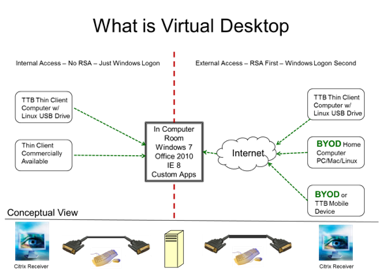Disappearing Desktop: How One Treasury Department Agency Uses Virtualization
Virtualization technology supports several government technology initiatives including teleworking and bring-your-own-device (BYOD) programs. One key benefit to virtualization of desktops is the reduction in hardware, because the actual computing power comes from a central point.
As the Alcohol and Tobacco Tax and Trade Bureau examined options for reducing costs and enabling more workers to telecommute, they found that virtualization was an investment that yielded many benefits.
Thin clients — computers that depend on a server to function — are an affordable way to deliver computing power to mobile employees. Because updates don’t require new devices for each user, thin clients also offer a reduction in future hardware expenses.
Here is an excerpt from the case study published on the Digital Government blog:
The Alcohol and Tobacco Tax and Trade Bureau (TTB) decided to reduce the costs, time and effort required to refresh desktop and laptop computers used for client computing needs. TTB has a widely dispersed workforce with many personnel working from home full time and over 80 percent of the workforce regularly teleworking. Replacing desktop and laptop computers every 3 to 4 years cost TTB about $2 million and disrupted the IT program and business users for several months. TTB determined that the best solution was to centralize all client computing power and applications, user data, and user settings and allow access to TTB resources by thin client computing devices. A thin client is a computing device or program that relies on another device for computational power. Currently about 70 percent of TTB personnel use thin client devices to access all TTB applications and data.
TTB desktop and laptop computers were due for refresh this year. However, the virtual desktop solution allowed TTB to avoid the expense of replacing hardware. The savings achieved paid for TTB’s virtual desktop implementation – which cost approximately $800,000 – and saved TTB $1.2 million.
Read the full case study at whitehouse.gov.
As with many other government initiatives, different technologies are closely tied together. Cloud computing affects mobile device usage, mobile devices affect security measures and virtualization affects telework. The successful evolution of technology in government relies heavily on the vision of the CIOs tasked with leading their agencies into the future.
Read more about other government agencies deploying virtual desktop infrastructure.









